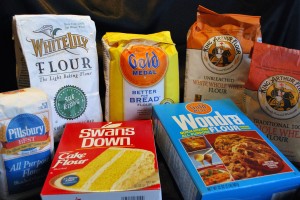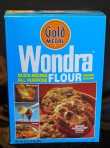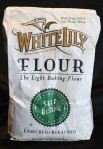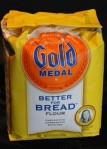Are you one of those people who prefer cooking to baking? Even as professional chefs go, very few openly embrace both aspects…just watch some of the cooking competition shows on TV and you’ll very likely see the “headlights in the eyes of a deer” look from more than one contestant. “Baking is too exact…it’s a science and cooking is an art” is a frequent refrain. True, but not completely. Cooking too is a science, but it’s more forgiving and you can usually coerce things along the way to get them go in the direction you want. Baking is definitely a science but it also requires a bit more concentration and faith…the waiting that goes with letting things rise, bake, and the “magic” that only time can tell. One of the key aspects to successful baking is to know what type of flour to use for the best results.
For clarification purposes, when I use the basic term “flour” I’m always referring to flour ground from wheat. Flour is the backbone of baked goods. It’s the “numero uno” of the baking world. Without it we wouldn’t have the variety of baked goods that we enjoy. Wheat flour is the “backbone” because it contains more gluten than any other grain, although barley and rye both have lesser degrees of it.
Gluten is a type of protein composed of two smaller components: Glutenin (which provides strength) and Gliadin (which provides elasticity). For the sake of keeping it simple, let’s think of them as guests at a party… When our two sociable friends first arrive at the “party” (think mixing bowl) they’re dry…no drinks yet so they might mix and pass by each other frequently but never really give each other the time of day. Then the party picks up and the liquid is a flowin’… Shazzam…glutenin and gliadin are suddenly having a swinging good time! They may not have given each other a second look earlier but now they’re smokin’ hot! Before you know it Glutenin and Gliadin are hooking up and connecting all over the place…..a crazy wild scene! Voila…Gluten is born.
Is “All-Purpose” Flour Really “All-Purpose”?
I’ve had people ask why after making a particular baked good for many years, suddenly they find that the results just don’t turn out the same. After a bit of poking and prodding it often turns out that the change in results coincides with either a physical move to a new region (even exclusive of high elevations…they have issues of their own) or a change in the brand of flour. What? Why would moving from one area to another suddenly make my cakes and pie crust tough, or cause my bread to deflate? It very often has to do with your flour. Even though most people use “all-purpose flour”, it’s important to note that “all-purpose” flours can vary greatly in their gluten content. Gluten can be the answer to your problems or the very source of them. It all depends on understanding when and why you want it.
Regional brands of flour mill their flours to provide the best results for the type of baking typically done by their sales demographic. In the Southern U.S., most brands such as White Lily, Martha White, Red Band, and many others know that people in their sales region tend to bake a lot more quick breads, cakes, cookies, pies, cobblers, and other items where tenderness is considered a key characteristic. In order to enhance the results that their customer’s receive from using their flour, these millers typically use a variety of wheat that is naturally lower in gluten content. The lower the protein content of a flour, the more tender the result will be (provided you’ve used proper technique!). Southern flours are often “bleached”. Flour is often bleached with chlorine gas which helps to lighten the color, weaken the gluten that is present in the flour, and cause the same quantity of flour to be able to absorb more liquid. The less flour that is needed in the recipe, the more tender the results.
Brands from the mid-west and northeast tend to use wheat that is higher in gluten content. King Arthur Flour (from Norwich, VT) is highly regarded by yeast bread bakers around the country. What makes it superior to other brands of flour? King Arthur uses wheat that is higher in gluten content than southern and national brands. Thus King Arthur flour will develop more gluten and thus have more of a “bite”, “tug” or “chewy” texture to the finished product.
If you tend to purchase “store brands” of products, keep smaller chains which are regionally based (Piggly Wiggly in the South/Wegman’s in Northeast) probably have their store brand of flour milled by a regional miller and the protein content most likely follows that of the bigger name regional mills. Therefore Piggly Wiggly brand flour would be likely to have less gluten than Wegman’s brand.
National brands such as Gold Medal and Pillsbury are being distributed nationally so their gluten content tends to be “middle of the road”.
What is the Difference Between All-Purpose, Cake, Self-Rising
and Other Flours?
The primary types of wheat flour that are found in most U.S. markets are going to include: cake flour, all-purpose flour, self-rising flour, bread flour, and whole wheat flour.
Instant blending flours such as “Wondra” or “Shake & Blend” are low protein flours that have been pre-gelatinized and then dried again to allow them to be able to hydrate more quickly without clumping. Originally designed to be used for thickening soups and sauces without the need to make a slurry (combination of flour and water), they can also be used for baked goods where tenderness is key: pie crusts and other tender pastries.
Why and When to Use Cake Flour:
Typically the softest (low gluten content) flour available. It is usually milled from soft spring wheat (planted in spring and harvested in fall) which naturally has a lower gluten content. Producers will typically blend varieties of wheat to achieve the targeted gluten content and bleach it, typically with chlorine gas. The bleaching of the flour further weakens the gluten-forming capability of the flour to further promote tenderness. Common brands include: Swansdown, SoftaSilk, and Presto. Cake flour is usually 7-9% protein.
Use cake flour for baked goods where tenderness is desired: Cakes,muffins, biscuits, pie crusts, cookies. Cookies made with cake flour will have less spread due to the acidic nature in the flour which is created by the bleaching process. Proteins will set more quickly in an acidic environment (think ceviche) and won’t spread as much. The resulting cookies won’t be quite as thin as those made with all-purpose flour.
Cake Flour Substitution: 1 cup of cake flour = 2 tablespoons of cornstarch in the bottom of an empty 1 cup measuring cup and then top off with all-purpose flour.
Why and When to Use All-Purpose Flour:
Designed for the home consumer to have decent results across a variety of baked goods. All-Purpose (AP) flour is usually blended from both hard and soft wheat in order to achieve the desired protein content. AP flour can vary greatly in protein content depending on regional producers. National brands tend to be middle of the road due to their broad distribution area and variety of baking done.
Why and When to use Self-Rising Flour:
Self-rising flour is all-purpose flour which has had baking powder and a small amount of salt mixed into it. Self-rising flour is used most predominantly in the southern U.S., usually for biscuits. Do not substitute self-rising flour for all-purpose flour in a recipe.
Substitution for Self-Rising Flour: 1 cup self-rising flour = 1 cup all-purpose flour + 1 teaspoon baking powder. Use cake flour in place of all-purpose flour in the substitution if a low-protein self-rising flour is not available.
Why and When to Use Bread Flour:
Bread flour has the highest gluten content available, usually about 12-14%. Bread flour will produce yeast doughs with maximum strength and bite, usually with more flavor. It is important to note that the higher gluten content will require a longer period of kneading in order to fully develop the available gluten. Bread flour also works well in other items where strength is needed such as puff pastry, popovers, and choux paste (cream puff/éclair dough).
Why and When to use Whole Wheat Flour:
Whole wheat flour is produced from the whole wheat kernel. The distinctive dark color, grainy flavor, and fiber is the result of the outer layer of the kernel known as the ‘bran’ being included when the grain is milled. While whole wheat flour is high in protein, it doesn’t form gluten very well. For best results in baking, whole wheat flour is always blended with bread or all-purpose flour in order to provide maximum elasticity. The fiber of the bran has a tendency to cut through the strands of gluten during kneading and creates a loaf of bread that is heavier and since the gluten hasn’t developed enough elasticity. Due to the oils contained in the germ of the wheat kernel, whole wheat flour can go rancid quickly. For best results, wrap tightly and store in the freezer.
Why and When to use White Whole Wheat Flour:
White whole wheat flour is a whole wheat flour that is milled from white (albino) wheat rather than the traditional red variety of wheat typically used. The white wheat kernel has a lighter color which also provides a milder flavor. White whole wheat flour can be used in place of up to 25% of all-purpose flour to provide a higher protein & fiber content in baked goods without giving the “whole wheat appearance” that would be noticeable with regular whole wheat flour.
Gluten Content & Recommended Use of Various Flours:
Type: Gluten:
Instant Blending 7-8%
Uses:
Designed for thickening sauces/soups
but can be used for any product where
tenderness is desired: pie crust, quick breads, cakes
Type: Gluten:
Cake Flour 7%-8%
Uses:
Cakes, Biscuits, Cookies, Pie Crusts
Type: Gluten:
White Lily Bleached
All-Purpose Flour 9.5%
(Southern Region)
Uses: Multiple, best used for quick breads, cakes,
And other items where tenderness is desired.
Type: Gluten:
Gold Medal Unbleached
All-Purpose Flour 10.5%
(National Brand)
Uses: Multiple uses- “middle of the road” for good results
In producing most baked goods.
Type: Gluten:
King Arthur Flour
Unbleached 11.7%
All-Purpose Flour
Uses: Multiple uses-great for yeast doughs and other
products where strength is desired
(cream puffs /popovers/puff pastry).
Type: Gluten:
Bread Flour 11-15%
Uses: Yeast doughs, Popovers,
Choux paste (cream puffs & éclairs)
Type: Gluten:
King Arthur Flour
White Whole Wheat Flour 13.2%
Uses: Use in place of regular whole wheat in order to increase fiber and protein content of baked goods without the appearance of being “whole wheat”.
Type: Gluten:
Whole Wheat Flour 14%
Uses: Used in whole wheat and multi-grain breads for
increased fiber and flavor. Despite having high gluten content it doesn’t develop gluten strands as efficiently due to the increased fiber from the bran which cuts and “shortens” the gluten resulting in a heavy, dense bread. For this reason, only about 25% of the flour in a recipe can be replaced with whole wheat flour.








